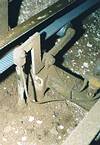
The fluidic muscle actuator is generating the same interest in mining and heavy industrial circles as it is enjoying in general engineering fields. Festo national sales manager, Heimo Spreng, believes that the unique invention is ideally suited to harsh operating environments, due in no small part to the pneumatic actuator being corrosion proof, sealed and impervious to dust.
"The fluidic muscle also offers up to 10 times the force of a traditional actuator of the same size," says Spreng. "Containing no conventional moving parts and no seals, it does not wear in harsh environments."

Already being applied in heavy industry as far afield as Mexico and Siberia, the fluidic muscle is being tested in new equipment and improvements conceived by the South African mining industry, already known worldwide for its ability to break new ground in terms of operational innovation. Employing a novel approach to precise and repeatable linear displacement technology, the fluidic muscle uses the concept of material deformation and flexure to achieve linear motion. This provides designers with an alternative, efficient both in relative size and weight, while providing up to 10 times more force than conventional cylinders.
The fluidic muscle employs a membrane-contraction system, which takes advantage of the same principle as an animal muscle. The basic concept involves the wrapping of a watertight, flexible hose with non-elastic fibres arranged in a rhomboidal fashion. This results in a three-dimensional grid pattern, and when compressed air is introduced into the system, the grid pattern is deformed. A pulling force is generated in the axial direction, resulting in a shortening of the muscle as internal pressure is increased.
Due to the relationship between the output force and the stroke of the fluidic muscle, it is difficult to compare fluidic muscles to traditional pneumatic cylinders. The overall weight is only about one eighth of the weight of a metal cylinder of equal inner diameter. Nevertheless, the force is up to 10 times greater. Very slow movements are possible, because the fluidic muscle is not encumbered by stick-slip effect, and on the other hand extremely high speeds are easily obtained. Positioning tasks can be performed with a simple change in pressure. End position cushioning is integrated, but an independent guide system for the load is required. Unlike conventional pneumatic cylinders, the stroke range of the fluidic muscle is typically 25% of its physical length.
The fluidic muscle demonstrates a whole series of other interesting characteristics: flexible movement characteristics, variable installation possibilities, no mechanical wear, less sensitive to contamination, resistant to many media and minimal compressed air consumption, as well as leak-free performance and easy transport. Areas of application thus span a broad range from stationary or mobile industrial use, up through consumer related applications. Festo is ready to partner with any mining or heavy industrial operations in finding further ways of exploiting this relatively young technology.
For more information contact Richard Teagle, managing director, Festo, 011 971 5500, [email protected], www.festo.com
| Email: | [email protected] |
| www: | www.festo.co.za |
| Articles: | More information and articles about Festo South Africa |

© Technews Publishing (Pty) Ltd | All Rights Reserved